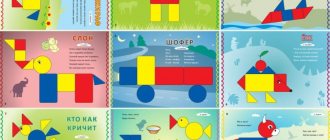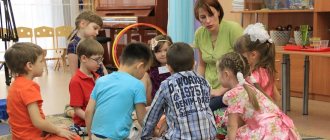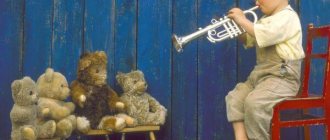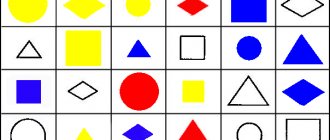The Hungarian psychologist and teacher has developed wonderful exercises and games that promote the development of mathematical concepts, as well as creative and logical thinking. Work on getting to know blocks begins in the second junior group, where kids identify one feature of an object. In the middle group, the tasks become more complicated, symbol cards appear, with the help of which children select the necessary figures. What games can be used with Dienesh blocks in older preschool age?
Games with Dienesha blocks in older preschool age
Children of senior preschool age are able to operate with several properties of an object at once. Children have developed imaginative thinking and are able to solve riddles, read symbols, engage in encoding and decoding. Preschoolers enjoy playing and doing exercises with Dienesh blocks. [ads1]
Game "Guess the riddle"
On a field of 4 or 5 parts, depending on the level of preparedness of the children, symbols of the figures are laid out, while the last window remains for guessing. For example, we put signs on the field: thin yellow and triangular. The child must place a thin yellow triangle in the empty window, and the size of the figure is not taken into account. You can make riddles from four symbols, for example: circle, thick, large, blue. In response, the child will put a blue, large, thick circle. The most difficult version of this game is with the negation of 1, 2, or 3 signs. The opposite game, “Make a Riddle,” is an empty tablet on which children, having chosen a figure, place the corresponding signs.
Educational game “Settling the Tenants”
The game “Settle the Tenants” is very exciting and students can play it in whole groups, and then test each other. In each apartment you need to place a tenant based on his characteristics (color, shape, size and thickness). For example, on the first floor there lives a blue, fat tenant, and on the second there is a red, not fat, but square tenant, on the third - not blue, rather large, round and thin. The houses are designed for children with different levels of preparedness, where it is necessary to take into account 2-4 signs and use negatives.
Educational game "Labyrinth"
Children happily respond to games like “Labyrinth”, “Tree”, etc., where they must find a place for their figure. Such games are aimed at developing the ability to classify blocks according to three characteristics and the ability to identify the main characteristics. Draw a tree with branches of different colors without leaves. Each branch has its own symbol indicating shape, size or thickness.
The child with the red large triangle must find a red branch with the “triangle and large” icon (or not a square, large, or a triangle, not small, etc.). It all depends on the level of development of the children and the creativity of the teacher. You can draw labyrinths, roads to garages, garden beds, and encode all information with icons. Such games bring great pleasure to children, and knowing about the “discoverer instinct”, you can achieve great results.
Educational game "Round Dance"
On winter evenings, and even on hot summer evenings, you can play dominoes or do round dances. To do this, divide all the blocks between the children and agree on the rules. The first player places any piece, and the next player must put a piece of a different size, or the same shape, but a different color, or a different shape, but the same size and thickness, etc. Children can come up with rules, and the teacher carefully monitors their implementation.
A few words about Zoltan Gyenes
Zoltan Pál Dienes has been interested in mathematics since childhood, so there is nothing strange in the fact that he decided to devote his entire life to the “queen of the exact sciences,” as well as its popularization not only in his native Hungary, but throughout the world. Already at the age of 23, Zoltan received a doctorate in mathematics, but did not rest on this and continued his education. In order to understand the mental processes involved in solving mathematical problems, he received an additional degree in psychology.
For most of his professional career, Dienes studied psycho-mathematics (for more than 10 years he headed the Center for the Study of Psycho-Mathematics at the University of Sherbrooke). Based on his own practical experience and the results of numerous studies, he developed a unique proprietary program for studying mathematics , accessible to children of various age categories.
Zoltán Dieneš's methodology is based on various logic games, exciting mathematical tasks and educational teaching aids aimed at stimulating children's interest in mathematics, as well as the development of combinatorics, logical thinking, analytical abilities, speech, memory and attention.
Games with hoops and Dienesha blocks
A special section in Dienesh’s methodology is devoted to games with hoops, which also begin with completing simple tasks and gradually become more complex, allowing the teacher to develop analytical thinking, mental flexibility and speed of reaction in future schoolchildren.
"Game with one hoop"
There is a hoop on the floor. Each child has one block in his hand. Children take turns placing blocks in accordance with the leader’s instructions. For example, inside the hoop are all red blocks, and outside the hoop are all the rest. Children are asked questions: What blocks are inside the hoop? (Reds). Which blocks were outside the hoop? (Non-red). This is the correct answer, because... the only important thing is that all the red blocks are inside the hoop and there are no others there, and the properties of the blocks outside the hoop are determined through the properties of those that lie inside. When repeating the game, children can choose for themselves which blocks to put inside, outside, and then determine to each other in one word the shapes outside the hoop.
"Game with two hoops"
There are two multi-colored hoops on the floor (blue and red), the hoops intersect, so they have a common part. The presenter invites someone to stand inside the blue hoop, inside the red hoop, inside both hoops, outside the red hoop, inside the blue but outside the red, inside the red but outside the blue, outside the blue and red hoops.
Then the children arrange the blocks so that all the round blocks are inside the blue hoop, and all the red ones are inside the red hoop.
At first, the problem is where to put the red and round blocks. Their place is in the common part of the two hoops. After completing the practical task of arranging blocks, children answer four questions:
- What blocks are inside both hoops?
- Inside the blue but outside the red hoop?
- Inside red but outside blue?
- Outside both hoops?
It should be emphasized that the blocks must be named here using two properties - shape and color.
"Game with three hoops"
During the game with three hoops, the task of classifying blocks according to three properties is solved, which is more complex than in the game with two hoops. The presenter places three multi-colored (red, blue, yellow) hoops on the floor as shown in the figure, i.e. to form 8 regions.
Once these areas are named appropriately in relation to the hoops (inside all three hoops, inside red and blue, but outside yellow, etc.), it is proposed to arrange the blocks, for example, so that all the red blocks are inside the red hoop, inside the blue they are all square, and inside the yellow they are all big.
After completing the practical task, children answer eight questions (standard for any version of the game with three hoops).
- What blocks are inside all three hoops?
- What blocks are inside the red and blue hoop, but outside the yellow hoop?
- What blocks are inside the blue and yellow hoop, but outside the red hoop?
- What blocks are inside the red and yellow hoop, but outside the blue hoop?
- What blocks are inside the red hoop, but outside the blue and outside the yellow hoop?
- What blocks are inside the blue hoop but outside the yellow and red hoop?
- What blocks are inside the yellow hoop, but outside the red and outside the blue hoop?
- Which blocks are outside all three hoops?
The game with three hoops models the partition of a set into eight classes (pairwise disjoint subsets) using three properties (being red, being square, being large). [ads2] Games with Dienesh blocks in older preschool age do not require special preparation, you only need to prepare special cards for joint and individual work. You can download an archive with cards for games with Dienesh blocks, which contains symbol cards and negation cards, as well as cards for the games “Guess the Riddle”, “Rest the Tenants”, “Logic Tables” of different difficulty levels.
Didactic material by Z. Dienesh
Author's logic blocks will introduce your child to the world of shape, color and size during casual mathematical play. The value of the didactic material of Z. Dienis:
- The most important psychological indicators of the development of logic and concentration, imagination, non-standard thinking and memory will receive an additional incentive for development.
- Working with the author's visual aids will develop speech, develop analysis and systematization skills, teach how to summarize information, and reveal the child's creative potential.
Each figure is characterized by four properties. The main goal is to teach the child to solve logical problems involving partitioning by properties
Flat version of Dienesh blocks. The kits can be widely used for: introducing children to standards of forms, teaching actions with standards. Cubes whose sides contain coded properties (shape, color, size, thickness) and the negation of properties (crossed out sign) Cubes whose sides contain properties, negation of properties. as well as numbers from three to eight Cards contain encoded information about the properties of an object The child takes a card with an example, solves it by decoding and selects the corresponding block
Schemes for making cakes The child places the selected block on the diagram with images of objects under the number that he determined as a result of solving the example on the card
The game “find a house for a lost figure”, in some houses one figure can live, in others - several Each ball is selected by solving a symbol card Correct decoding of information will allow you to select the necessary blocks and figures
Each page of the album is an illustration on which the child will have to place blocks of the appropriate color, size and shape according to the example: Option 1 - offer to move one resident into each apartment, Option 2 - two residents into each apartment. You can easily draw such a diagram yourself
This is how you can draw a symbol card by hand
At home, the album can be replaced with regular coloring
Scheme for making logical figures
Parameters of the sides of logical figures
Math blocks
The classic set of teaching blocks includes 48 parts of various colors, sizes and shapes. The elements are made in accordance with the main list of geometric shapes and have the following characteristics:
- Four block shapes: square, round, triangle and rectangle;
- Three color options: blue, red and yellow.
- Two thickness options: thick, thin;
- Two size options: large, small.
It is also fundamentally important that the set does not contain identical geometric blocks.
Video: Gyenes Logic Blocks
https://youtube.com/watch?v=CV_PU3fUuf0
Logical figures
One set for organizing classes in a small subgroup contains 24 flat figures, which include an equal number (6 elements each) of squares, triangles, rectangles and circles, as well as blocks of different colors (red, yellow, blue) and size (large, small). A visual aid with logical figures is necessary for working with the concept of a form standard and learning to manipulate standards.
Logic cubes
Cubes, the sides of which contain a coded image of characteristics (shape, color, size, thickness) and the negation of properties (a crossed out sign), as well as a cube with numbers from three to eight on each side. This didactic material is important for mastering the mental operations of substitution, symbolic encryption, decoding, and spatial modeling. The originality of logic cubes lies in the variability of the spontaneous choice of properties, which is made by tossing the cube, and this always causes delight and interest in children.
To complete the task, the child must master the skills of decoding the symbols depicted on the faces of the logic cube
Cards with symbolic transmission of information about the properties of an object, as well as arithmetic examples.
- It will help the child to master the cultural tradition of symbolic, encoded in a symbol, transmission of information about the characteristics of an object.
- Will develop the ability to perform abstract mental operations and decipher symbols.
- Builds mental arithmetic skills.
Albums, algorithmic schemes
The goal is to teach the child to strictly follow the rules and strictly follow the prescribed sequence of steps. Schematically indicate the path that needs to be taken to solve the problem.
Ribbons or hoops can serve as additional didactic tools for defining the playing area; with their help, you can expand the range of exercise options, make them more varied and exciting.
Do-it-yourself materials by Z. Dienis
Most of the games can be played using flat figures, and they can be cut out of cardboard, colored paper, painted with colored pencils or paints; variants of card schemes can also be invented independently, by analogy with ready-made ones, and drawn by hand. If it is difficult to find sets of additional cards or albums on sale, then you can print algorithmic or digital cards or album options on a color printer.
Each page of the album is an illustration on which the child will have to place blocks of the appropriate color, size and shape according to the pattern. The pictures are structured according to the principle “from simple to complex” - at the beginning there are pictures consisting of a minimum number of details
Disadvantages of the Dienes system
Strange as it may seem, experts did not find any shortcomings in Dienesh’s system . However, studying the reviews of parents who are already engaged in this system made it possible to identify such shortcomings as:
- Limited color variety in Dienes blocks;
- For older kids who solve more complex problems, one set of Dienesh blocks is sometimes not enough;
- The concept of “thickness” is incorrect, as a result of which it is sometimes difficult to explain to a child, for example, why a square is always flat;
- In Russia it is quite difficult to find albums for classes using the Dienesh system.
Subscribe to our Telegram to stay up to date with important news in the field of education.
Features of the Dienesh system
Zoltan Dienes's method includes six interconnected stages of studying mathematics, which take into account the psychological aspects of solving mathematical problems.
The first stage is free play, during which children try to solve an unfamiliar problem by trial and error, trying out different solutions.
The second stage is studying the rules of the game, with the help of which the necessary mathematical information is “conveyed” to children.
The third stage is a comparison that allows you to diversify games with a similar rule structure with different materials, and thereby come to the understanding that changing the material does not change the essence of the game.
The fourth stage is familiarization with the content of numbers, thanks to which the child begins to understand the essence of the game and the common component of all mathematical games.
The fifth stage is symbolic, which includes the description of game cards using symbols, for which the child can come up with his own symbolic systems.
The sixth stage, formalization, consists of considering several options for describing game cards, as a result of which the child understands that the initial description can be an axiom, and his own conclusions can be a theorem.
Let us emphasize that Dienesh’s method completely excludes solving mathematical problems in notebooks or studying mathematical rules in boring textbooks. All activities are fun games, songs and dances during which children easily and quickly acquire mathematical knowledge and skills, and also get their first understanding of such complex mathematical concepts as algorithms, logical operations and information coding. At the same time, children, most often, do not even realize how complex concepts they are mastering in the course of exciting classes according to the “new mathematics” program of Zoltan Dienes .







